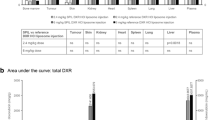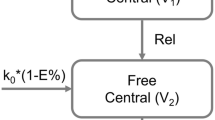Abstract
Purpose
To compare the pharmacokinetic bioequivalence and safety of a generic pegylated liposomal doxorubicin formulation (SPIL DXR hydrochloride liposome injection) with that of the reference products, Caelyx or Doxil.
Methods
Two open-label, two-way reference crossover studies were conducted in patients with ovarian cancer. Cmax, AUC0 − t, and AUC0−∞, Vd, and Cl for total, free, and encapsulated DXR were evaluated in 18 blood samples taken pre-dose (t = 0), at increasing time intervals over the following 14 days. A washout period of 28 days was observed before crossing over.
Results
Studies 1 and 2 were completed by 24/29 and 41/60 patients, respectively. Pharmacokinetic data from 24 patients from each study established bioequivalence for free DXR in study 2, and for total and encapsulated DXR in both studies. Data from 29 and 54 patients, respectively, were included in the safety evaluation. Of these, 37 patients experienced 81 post-dose adverse events (40 related to the test product and 41 related to the reference product). In study 1, four patients were withdrawn owing to adverse events. Eleven patients experienced serious adverse events and one death occurred in study 2.
Conclusions
Bioequivalence between the test and the reference products was established for total and encapsulated DXR in both studies, and for free DXR in the study with the larger sample size (study 2). There were no significant differences between the safety profiles of the generic formulation and the reference products. No correlation was found between drug level and adverse events.
Trial registration
Study 1 was registered retrospectively; registration number is NCT03055143, dated February 15, 2017. Study 2 registration number is NCT00862355, dated March 13, 2009.


Similar content being viewed by others
References
Matsumoto K, Onda T, Yaegashi N (2015) Pharmacotherapy for recurrent ovarian cancer: current status and future perspectives. Jpn J Clin Oncol 45(5):408–410. https://doi.org/10.1093/jjco/hyv014
Steinherz LJ, Steinherz PG, Tan CC, Heller G, Murphy M (1991) Cardiac toxicity 4 to 20 years after completing anthracycline therapy. JAMA 266(12):1672–1677. https://doi.org/10.1001/jama.1991.03470120074036
Goorin AM, Chauvenet AR, Perez-Atayde AR, Cruz J, McKone R, Lipshultz SE (1990) Initial congestive heart failure, six to ten years after doxorubicin chemotherapy for childhood cancer. J Pediatr 116(1):144–147
Benjamin RS, Wiernik PH, Bachur NR (1974) Adriamycin chemotherapy–efficacy, safety, and pharmacologic basis of an intermittent single high-dosage schedule. Cancer 33(1):19–27
Ali SMSS, Ahmad A, Ahmad MU, Chen P, Paithankar M, Choudhury K, Makadia RD, Kumar A, Velavan K, Satheesh CT, Singh JK, Mamillapalli G, Saptarishi D, Kale P, Patel R, Barkate HV, Ahmad I (2016) Bioequivalence study of pegylated doxorubicin hydrochloride liposome (PEGADRIA) and DOXIL® in ovarian cancer patients: physicochemical characterization and pre-clinical studies. J Nanomed Nanotechnol 7:361. https://doi.org/10.4172/2157-7439.1000361
Vici P, Colucci G, Giotta F, Sergi D, Filippelli G, Perri P, Botti C, Vizza E, Carpino A, Pizzuti L, Latorre A, Giannarelli D, Lopez M, Di Lauro L (2011) A multicenter prospective phase II randomized trial of epirubicin/vinorelbine versus pegylated liposomal doxorubicin/vinorelbine as first-line treatment in advanced breast cancer. A GOIM study. J Exp Clin Cancer Res: CR 30:39. https://doi.org/10.1186/1756-9966-30-39
Broder H, Gottlieb RA, Lepor NE (2008) Chemotherapy and cardiotoxicity. Rev Cardiovasc Med 9(2):75–83
Swain SM, Whaley FS, Ewer MS (2003) Congestive heart failure in patients treated with doxorubicin: a retrospective analysis of three trials. Cancer 97(11):2869–2879. https://doi.org/10.1002/cncr.11407
Rahman AM, Yusuf SW, Ewer MS (2007) Anthracycline-induced cardiotoxicity and the cardiac-sparing effect of liposomal formulation. Int J Nanomed 2(4):567–583
Rafiyath SM, Rasul M, Lee B, Wei G, Lamba G, Liu D (2012) Comparison of safety and toxicity of liposomal doxorubicin vs. conventional anthracyclines: a meta-analysis. Exp Hematol Oncol 1:10–10. https://doi.org/10.1186/2162-3619-1-10
van Dalen EC, Michiels EM, Caron HN, Kremer LC (2010) Different anthracycline derivates for reducing cardiotoxicity in cancer patients. Cochrane Database Syst Rev. https://doi.org/10.1002/14651858.CD005006.pub4
Mayer LD, Tai LC, Ko DS, Masin D, Ginsberg RS, Cullis PR, Bally MB (1989) Influence of vesicle size, lipid composition, and drug-to-lipid ratio on the biological activity of liposomal doxorubicin in mice. Cancer Res 49(21):5922–5930
O’Brien ME, Wigler N, Inbar M, Rosso R, Grischke E, Santoro A, Catane R, Kieback DG, Tomczak P, Ackland SP, Orlandi F, Mellars L, Alland L, Tendler C (2004) Reduced cardiotoxicity and comparable efficacy in a phase III trial of pegylated liposomal doxorubicin HCl (CAELYX/Doxil) versus conventional doxorubicin for first-line treatment of metastatic breast cancer. Ann Oncol 15(3):440–449
Keller AM, Mennel RG, Georgoulias VA, Nabholtz JM, Erazo A, Lluch A, Vogel CL, Kaufmann M, von Minckwitz G, Henderson IC, Mellars L, Alland L, Tendler C (2004) Randomized phase III trial of pegylated liposomal doxorubicin versus vinorelbine or mitomycin C plus vinblastine in women with taxane-refractory advanced breast cancer. J Clin Oncol 22(19):3893–3901. https://doi.org/10.1200/jco.2004.08.157
Briasoulis E, Pentheroudakis G, Karavasilis V, Tzamakou E, Rammou D, Pavlidis N (2004) Weekly paclitaxel combined with pegylated liposomal doxorubicin (CaelyxTM) given every 4 weeks: dose-finding and pharmacokinetic study in patients with advanced solid tumors. Ann Oncol 15(10):1566–1573. https://doi.org/10.1093/annonc/mdh404
Batist G, Ramakrishnan G, Rao CS, Chandrasekharan A, Gutheil J, Guthrie T, Shah P, Khojasteh A, Nair MK, Hoelzer K, Tkaczuk K, Park YC, Lee LW (2001) Reduced cardiotoxicity and preserved antitumor efficacy of liposome-encapsulated doxorubicin and cyclophosphamide compared with conventional doxorubicin and cyclophosphamide in a randomized, multicenter trial of metastatic breast cancer. J Clin Oncol 19(5):1444–1454
Schmid P, Krocker J, Jehn C, Michniewicz K, Lehenbauer-Dehm S, Eggemann H, Heilmann V, Kümmel S, Schulz CO, Dieing A, Wischnewsky MB, Hauptmann S, Elling D, Possinger K, Flath B (2005) Primary chemotherapy with gemcitabine as prolonged infusion, non-pegylated liposomal doxorubicin and docetaxel in patients with early breast cancer: final results of a phase II trial. Annals Oncol 16(10):1624–1631. https://doi.org/10.1093/annonc/mdi321
Safra T, Muggia F, Jeffers S, Tsao-Wei DD, Groshen S, Lyass O, Henderson R, Berry G, Gabizon A (2000) Pegylated liposomal doxorubicin (doxil): reduced clinical cardiotoxicity in patients reaching or exceeding cumulative doses of 500 mg/m2. Ann Oncol 11(8):1029–1033
Tuscano JM, Martin SM, Ma Y, Zamboni W, O’Donnell RT (2010) Efficacy, biodistribution, and pharmacokinetics of CD22-targeted pegylated liposomal doxorubicin in a B-cell non-Hodgkin’s lymphoma xenograft mouse model. Clin Cancer Res 16(10):2760–2768. https://doi.org/10.1158/1078-0432.ccr-09-3199
Markman M, Kennedy A, Webster K, Peterson G, Kulp B, Belinson J (2000) Phase 2 trial of liposomal doxorubicin (40 mg/m2) in platinum/paclitaxel-refractory ovarian and fallopian tube cancers and primary carcinoma of the peritoneum. Gynecol Oncol 78(3 Pt 1):369–372. https://doi.org/10.1006/gyno.2000.5921
Drummond DC, Meyer O, Hong K, Kirpotin DB, Papahadjopoulos D (1999) Optimizing liposomes for delivery of chemotherapeutic agents to solid tumors. Pharmacol Rev 51(4):691–744
Adams SF, Marsh EB, Elmasri W, Halberstadt S, VanDecker S, Sammel MD, Bradbury AR, Daly M, Karlan B, Rubin SC (2011) A high response rate to liposomal doxorubicin is seen among women with BRCA mutations treated for recurrent epithelial ovarian cancer. Gynecol Oncol 123(3):486–491. https://doi.org/10.1016/j.ygyno.2011.08.032
Strauss HG, Hemsen A, Karbe I, Lautenschlager C, Persing M, Thomssen C (2008) Phase II trial of biweekly pegylated liposomal doxorubicin in recurrent platinum-refractory ovarian and peritoneal cancer. Anti-cancer Drugs 19(5):541–545. https://doi.org/10.1097/CAD.0b013e3282fcbbf7
European Medicines Agency (2010) Caelyx doxorubicin hydrochloride. http://www.ema.europa.eu/ema/index.jsp?curl=pages/medicines/human/medicines/000089/human_med_000683.jsp&mid=WC0b01ac058001d124. Accessed 10 July 2018
Barenholz Y (2012) Doxil(R)--the first FDA-approved nano-drug: lessons learned. J Control Release 160(2):117–134. https://doi.org/10.1016/j.jconrel.2012.03.020
Ait-Oudhia S, Mager DE, Straubinger RM (2014) Application of pharmacokinetic and pharmacodynamic analysis to the development of liposomal formulations for oncology. Pharmaceutics 6(1):137–174. https://doi.org/10.3390/pharmaceutics6010137
Lionberger R (2015) Pharmaceutical science for generic drugs: the science of equivalence. http://www.nipte.org/sites/default/files//documents/Lionberger.pdf. Accessed 23 Sept 2016
Gaspani SM, B (2013) Access to liposomal generic formulations: beyond AmBisome and Doxil/Caelyx. GaBI J 2(2):60–62
Davit BM, Nwakama PE, Buehler GJ, Conner DP, Haidar SH, Patel DT, Yang Y, Yu LX, Woodcock J (2009) Comparing generic and innovator drugs: a review of 12 years of bioequivalence data from the United States Food and Drug Administration. Ann Pharmacother 43(10):1583–1597. https://doi.org/10.1345/aph.1M141
Committee for Human Medicinal Products (CHMP) (2013) Reflection paper on the data requirements for intravenous liposomal products developed with reference to an innovator liposomal product. London, UK
US Food and Drug Administration (2017) Draft guidance on doxorubicin hydrochloride. http://www.fda.gov/downloads/Drugs/GuidanceComplianceRegulatoryInformation/Guidances/UCM199635.pdf. Accessed 25 June 2018
US Food and Drug Administration (2001) Guidance for industry. bioanalytical method validation
Committee for Medicinal Products for Human Use (CHMP) (2010) Guideline on the investigation of bioequivalence. London, UK
Bhowmik S, Bhowmick S, Maiti K, Chakra A, Shahi P, Rajamannar T (2017) Phase-I randomized trial of doxorubicin hydrochloride liposome injection versus Caelyx((R)) in multiple myeloma. Leuk Lymphoma. https://doi.org/10.1080/10428194.2017.1382692
Burade V, Bhowmick S, Maiti K, Zalawadia R, Jain D, Rajamannar T (2017) Comparative plasma and tissue distribution of Sun Pharma’s generic doxorubicin HCl liposome injection versus Caelyx((R)) (doxorubicin HCl liposome injection) in syngeneic fibrosarcoma-bearing BALB/c mice and Sprague-Dawley rats. Cancer Chemother Pharmacol 79(5):899–913. https://doi.org/10.1007/s00280-017-3278-9
Burade V, Bhowmick S, Maiti K, Zalawadia R, Ruan H, Thennati R (2017) Lipodox(R) (generic doxorubicin hydrochloride liposome injection): in vivo efficacy and bioequivalence versus Caelyx(R) (doxorubicin hydrochloride liposome injection) in human mammary carcinoma (MX-1) xenograft and syngeneic fibrosarcoma (WEHI 164) mouse models. BMC cancer 17(1):405. https://doi.org/10.1186/s12885-017-3377-3
Smith JA, Costales AB, Jaffari M, Urbauer DL, Frumovitz M, Kutac CK, Tran H, Coleman RL (2016) Is it equivalent? Evaluation of the clinical activity of single agent Lipodox(R) compared to single agent Doxil(R) in ovarian cancer treatment. J Oncol Pharm Pract 22(4):599–604. https://doi.org/10.1177/1078155215594415
Acknowledgements
Medical writing support was provided by Claire Aukim-Hastie and Diane Kwiatkoski of IQVIA. Funding for the study and for editorial assistance with this manuscript was provided by Sun Pharmaceutical Industries Limited.
Funding
Funding for the study and for editorial assistance with this manuscript was provided by Sun Pharmaceutical Industries Ltd.
Author information
Authors and Affiliations
Contributions
ShB was the clinical lead on this trial, involved in study design, protocol review, and study conduct. SB was the lead formulation development scientist on this trial, involved in product development starting from conceptualization to marketing of the product, and provided the investigational product. KM was a formulation development scientist on this trial and was involved in the development, manufacture, and provision of the investigational product. AC was involved in protocol development and authored the clinical study reports. PS was the clinical pharmacology lead, involved in analytical method development and pharmacokinetic bioanalysis. DJ was the project supervisor with regard to bioanalysis, method validation, and analytical method development. RT was the research and development head, and was involved in product development and provided clinical trial oversight. All authors helped write the manuscript and have read and approved the final manuscript.
Corresponding author
Ethics declarations
Conflict of interest
All authors were paid employees of Sun Pharmaceutical Industries Ltd. (SPIL) at the time the study was conducted. ShB, SB, KM, PS, and RT are shareholders in SPIL. ShB and KM are salaried employees of Sun Pharma Advanced Research Company (SPARC). KM also owns shares in SPARC.
Ethics approval
The studies were approved by the Drug Controller General of India and performed at three (study 1) and five (study 2) sites across India in accordance with the Guidelines for Good Clinical Practice (GCP) and the Declaration of Helsinki. The study 1 protocol and informed consent form were approved by the Institutional Ethics Committee of the MNJ Institute of Oncology and Regional Cancer Center, Hyderabad, India; the Institutional Ethics Committee of Rajah Hospital, Madurai, India; and the Institutional Ethics Committee of the Chittaranjan National Cancer Institute, Kolkata, India. The study 2 protocols and informed consent forms were approved by the Institutional Ethics Committee of the MNJ Institute of Oncology and Regional Cancer Center, Hyderabad, India; the Institutional Ethics Committee of NRR Hospital, Bangalore, Karnataka, India; the Vadodara Ethics Committee of Kailash Cancer Hospital and Research Centre, Goraj, Vadodara, India; the Medical Ethics Committee of Dr. Kamakshi Memorial Hospital, Chennai, India; and the Ethics Committee of Dr. G. Viswanathan Speciality Hospitals, Tamil Nadu, India.
Informed consent
For both studies, all patients provided written informed consent before participating in the study.
Animal rights
This article does not contain any studies with animals performed by any of the authors.
Rights and permissions
About this article
Cite this article
Bhowmik, S., Bhowmick, S., Maiti, K. et al. Two multicenter Phase I randomized trials to compare the bioequivalence and safety of a generic doxorubicin hydrochloride liposome injection with Doxil® or Caelyx® in advanced ovarian cancer. Cancer Chemother Pharmacol 82, 521–532 (2018). https://doi.org/10.1007/s00280-018-3643-3
Received:
Accepted:
Published:
Issue Date:
DOI: https://doi.org/10.1007/s00280-018-3643-3




